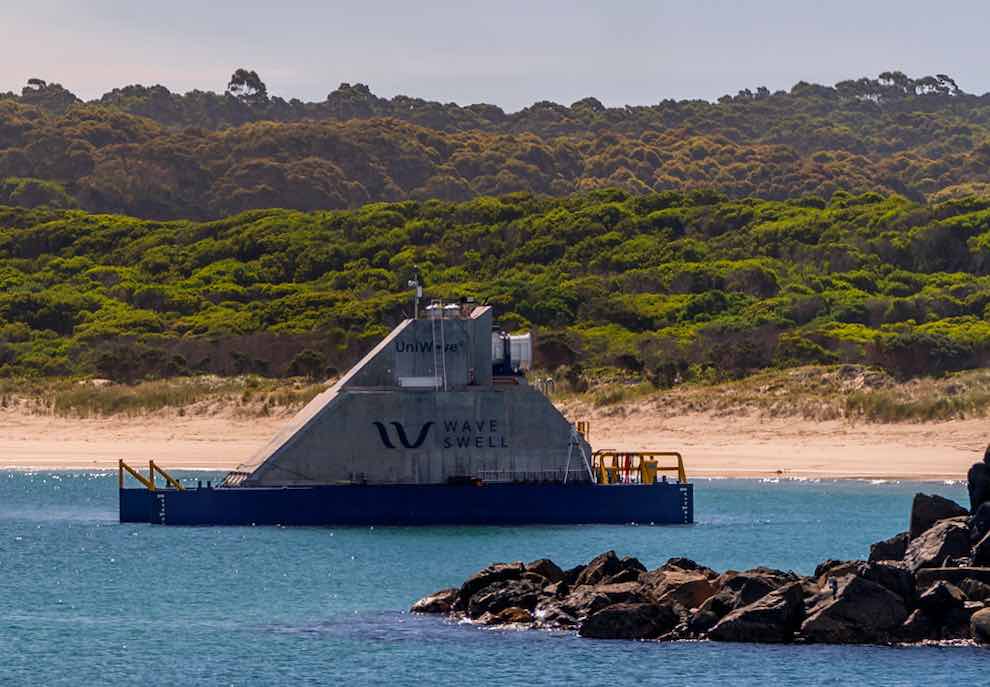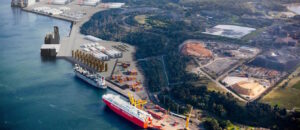An innovative Australian wave energy generator has been deployed in the ocean off King Island, where it will be connected to the Bass Strait island’s power grid and tested alongside existing wind, solar and diesel resources – a first in Australia and possibly the world.
Melbourne-based company Wave Swell Energy said the 200kW Uniwave unit, or Uniwave200, had been installed successfully adjacent to the Grassy harbour, in King Island’s south, and was “sitting proudly” on the seabed in about 5.75 metres of water.
The “oscillating water column” (OWC) technology, which the company has likened to an “artificial blowhole,” works by using waves to produce high pressure air, which is converted into electricity by a turbine.
The King Island project marks the technology’s first real-world demonstration, after extensive testing in a wide range of simulated conditions at the Australian Maritime College in Launceston.
The world-first demonstration project, which has been backed by the Australian Renewable Energy Agency, is being conducted over an initial 12-month period in conjunction with local network owner Hydro Tasmania.
The trial was first flagged back in July of 2019, but progress was brought to a halt in early 2020 by the onset of the Covid-19 global pandemic which, for several months, prevented the Melbourne-based WSE team from even entering Tasmania, where the Uniwave200 was being built.
With the unit now safely in place, the idea is for it to complement Hydro Tasmania’s existing hybrid grid, the ground-breaking KIREIP (King Island Renewable Energy Integration) project, boosting and diversifying the existing wind and solar generation sources and further cutting diesel consumption.
For WSE, the project is expected to verify how the unit will perform in different wave conditions and to validate the technology’s “many world-leading aspects,” including its efficiency, robustness, and accessibility.
Remote island microgrids such as is being developed on King Island are one of the key markets being targeted by WSE, while a more recent focus of the company includes breakwater and seawall applications.
WSE co-founder and CEO Tom Denniss told RenewEconomy the company was particularly excited about the potential for the latter application of the technology, as a two-pronged climate solution for islands nations seeking to cut their use of fossil (diesel) fuel and brace against sea-level rise and coastal erosion that is being accelerated by increasingly frequent extreme weather events.
“Places like the Maldives … are very vulnerable and will eventually, over the coming decades, likely need sea walls built around every metre of every island. Why not make them an energy producing breakwater or sea wall, and get double benefits,” Denniss told RenewEconomy.
“We’re already in discussions with two different groups in other parts of the world [about this application of the Uniwave] because they can see the benefit in that as well.”
WSE said in early January that the commissioning of the King Island unit would take place over “coming weeks,” with the Uniwave200 expected to be connected to Hydro Tasmania’s hybrid grid during Q1, 2021.
“Once operating and providing electricity, King Island will be the first remote island grid in the world to be powered by three separate renewables – waves, wind, and solar,” a company statement said.
For now, however, the safe arrival and installation of the unit in its designated spot in Grassy Harbour – after what WSE described as a “flawless” 40-hour trip from Hobart – is in itself a significant milestone.
As RenewEconomy has reported, one-time OWC hopeful Oceanlinx went into receivership in 2014 after a commercial-scale generator it was hoping to deploy in waters off Port MacDonnell in South Australia in 2013 was damaged en route to its underwater destination.
Denniss has described the Uniwave technology as an new-and-improved take on existing OWC technology, with potential to generate very cheap, clean energy.
The key difference is in WSE’s uni-directional, instead of bi-directional, design, which means that it only extracts energy on the downstroke of the compressed air.
Counter-intuitively, as Denniss explained in 2019, the team discovered that this approach – while reducing the complexity of the turbine – also generates more energy than the bi-directional system.
“By extracting only on the downstroke… despite only getting energy one way, we actually get about 15 per cent more energy just on the downstroke than on the up and down combined.
“The turbine then is much simpler, cheaper, and more robust. And the blades are fixed and can have twist in them, which creates more efficiency,” Denniss said.
“So there’s greater efficiency from the turbine as well as more conversion efficiency, and that obviously has major effects on the cost efficiency.
“And there’s less moving parts – and none, whatsoever, in or below the water line, so no adverse affects on marine life.”
Back in 2019, Denniss said that the company expected the Uniwave technology – if deployed at a large scale, as multi-unit, multi-megawatt wave farm – to produce energy at 10c/kWh.
In comments this week, he said that the cost of power generated by Uniwave systems was expected to get down even further once the technology was being installed at a global scale comparable to solar and wind today.
“At that scale it would be more than competitive with solar and wind,” Denniss told RE, “because at equivalent starting points, in terms of amount of capacity installed worldwide, out costs are much lower.”










